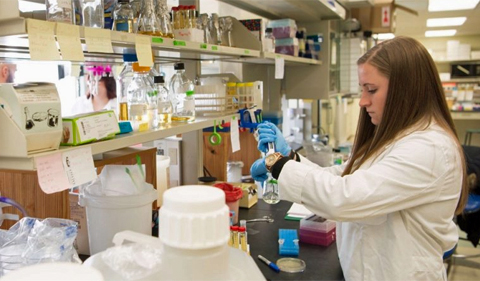Rebecca Keogh, a graduate student in Biological Sciences, was the lead author on a paper in the journal Infection and Immunity.
The paper describes an intracellular protein in Staphylococcus aureus that is required for the bacteria to cause disease. Keogh showed that while the protein (called PpiB) is necessary to cause disease, the way in which the protein functions is still a mystery. An analysis of the PpiB sequence had suggested it was an enzyme that played a role in protein folding; however, results published in the paper show that this is not the case and that PpiB has some unknown activity that allows S. aureus to cause disease. Keogh is continuing to investigate the PpiB protein to understand what this activity is.
Keorgh’s article is titled “The intracellular cyclophilin PpiB contributes to the virulence of Staphylococcus aureus independent of its PPIase activity.”
Her co-authors are Dr. Ronan Carroll, Assistant Professor of Biological Sciences; graduate student Rachel L. Zapf; lab manager and OHIO alum Richard E. Wiemels; and undergraduate Marcus A. Wittekind.
Abstract: The Staphylococcus aureus cyclophilin PpiB is an intracellular peptidyl prolyl cistrans isomerase (PPIase) that has previously been shown to contribute to secreted nuclease and hemolytic activity. In this study, we investigate the contribution of PpiB to S. aureus virulence. Using a murine abscess model of infection, we demonstrate that a ppiB mutant is attenuated for virulence. We go on to investigate the mechanism through which PpiB protein contributes to virulence, in particular the contribution of PpiB PPIase activity. We determine the amino acid residues that are important for PpiB PPIase activity and show that a single amino acid substitution (F64A) completely abrogates PPIase activity. Using purified PpiB F64A protein in vitro, we show that PPIase activity only partially contributes to Nuc refolding and that PpiB also possesses a PPIase-independent activity. Using allelic exchange, we introduce the F64A substitution onto the S. aureus chromosome, generating a strain that produces enzymatically inactive PpiB. Analysis of the PpiB F64A strain reveals that PPIase activity is not required for hemolysis of human blood or virulence in a mouse. Together, these results demonstrate that PpiB contributes to S. aureus virulence via a mechanism unrelated to prolyl-isomerase activity.




















Comments